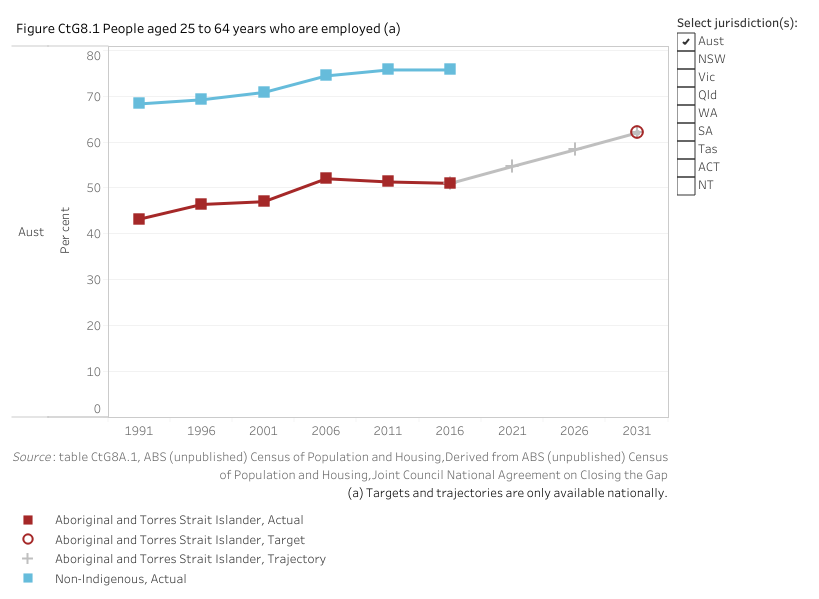TARGET 8
By 2031, increase the proportion of Aboriginal and Torres Strait Islander people aged 25-64 who are employed to 62 per cent
Dashboard snapshot: The data below are the most recent at the time of preparing the July 2021 report. Please go to the dashboard to access the current data.
Nationally in 2016, 51.0 per cent of Aboriginal and Torres Strait Islander people aged 25–64 years were employed (figure CtG8.1).
There are no new data since the baseline year of 2016.

Target data specifications
Outcome: | Strong economic participation and development of Aboriginal and Torres Strait Islander people and communities. |
|---|---|
Target: | By 2031, increase the proportion of Aboriginal and Torres Strait Islander people aged 25-64 who are employed to 62 per cent. |
Indicator: | The proportion of Aboriginal and Torres Strait Islander people aged 25-64 years who are employed. |
Measure: | The measure is defined as: Numerator — number of Aboriginal and Torres Strait Islander people aged 25-64 years who are employed Denominator — total number of Aboriginal and Torres Strait Islander people in the population aged 25-64 years and is presented as a percentage. |
Target established: | National Agreement on Closing the Gap July 2020 |
Latest dashboard update: | 23 June 2021 |
Indicator type: | Target |
Interpretation of change: | A high or increasing proportion is desirable. An increase from the baseline year is an improvement. |
Data source: | Name: ABS Census of Population and Housing, Census Table Builder (Basic) Frequency: Five-yearly Documentation (links): www.abs.gov.au/census |
Data provider: | Provider name: Australian Bureau of Statistics Provider area: Census |
Baseline year: | 2016 |
Target year: | 2031 |
Disaggregations: | State and territory and Australia, by Indigenous status |
Computation: | Numerator divided by Denominator multiplied by 100 Counting rules Data are for all Australian residents enumerated in the Census that reported having a usual residence in Australia. Geographical variables are based on a person’s place of usual residence. Includes (both numerator and denominator):
Excludes (both numerator and denominator):
Extraction Census Table Builder (Basic) – Employment, Income and Education: INGP X Main ASGS (UR) X LFSP X AGE5P |
Data quality considerations: | Data values have been randomly adjusted using perturbation to avoid the release of confidential data. |
Future reporting: | Additional disaggregations required for future reporting:
|
Supporting indicators
Driver
- Highest level of educational attainment
- Long term health and disability status
- Caring responsibilities
Contextual information
- Employment by occupation
- Employment by industry
- Median equivalised gross household income
- Median personal income
- Labour force participation
- Self-managed business owners
- Progress towards parity
